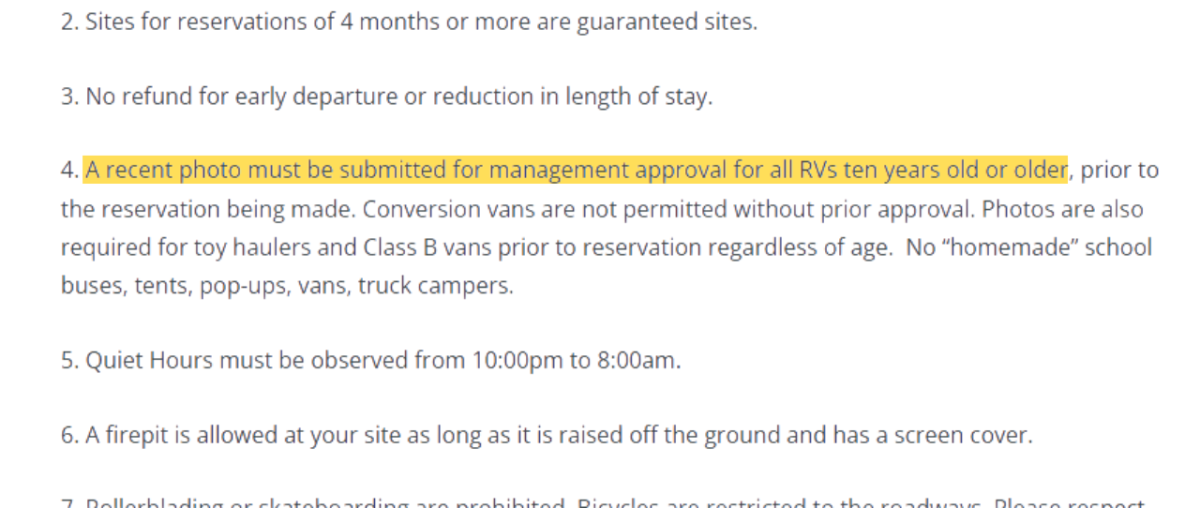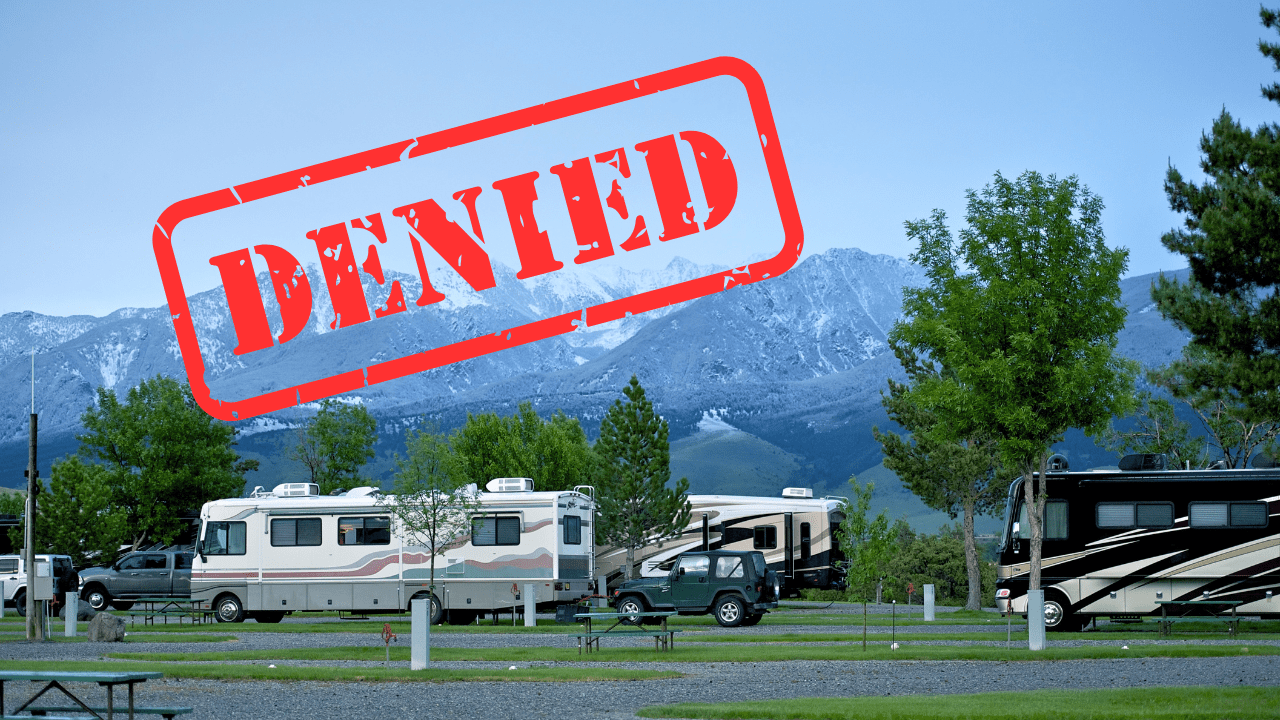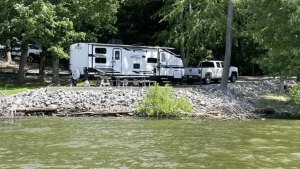The 10-year rule has become one of the more debated policies in the RV world. Some RVers see it as a way to unfairly block older rigs, even when they’re in excellent shape. Others argue it’s a park’s right to set standards for what’s allowed on their property.
So, how often is this rule actually used? Are RVs really getting turned away just for being “too old”? And what can you do if your RV is past that ten-year mark?
Let’s take a closer look at what the rule is, why parks enforce it, and the best ways to work around it.
What Is the 10-Year Rule?
The “10-Year Rule” is a policy used by some privately owned RV parks and resorts that allows them to restrict or deny entry to recreational vehicles that are more than ten years old.
This rule isn’t based on mechanical condition, mileage, or type of RV. It’s strictly based on the model year.
It’s not a government regulation or industry-wide requirement. There is no federal or state law that enforces it. Instead, it’s a private rule that some park owners choose to put in place as part of their business policies. You’ll typically see it listed on the park’s website under the “Rules,” “Rates,” or FAQ sections. In some cases, parks won’t mention it publicly but will apply it during the booking or check-in process.
There are a few variations of how this rule is enforced:
- A few extend the rule to fifteen years instead of ten.
- Some parks have a strict cutoff and will not allow RVs older than ten years under any circumstances.
- Others will ask for recent photos and may allow older rigs if they appear clean, undamaged, and well-maintained.
- Some may only apply the rule during peak seasons or to long-term stays.
Why Do Parks Use It?
RV parks that enforce the 10-year rule usually do it for a few specific reasons:
- To Keep the Park Looking Well-Maintained
Some parks want a certain appearance, especially those that market themselves as high-end or “resort-style.” They feel that older RVs, regardless of condition, might not match the image they’re going for. Even well-cared-for rigs can look dated next to newer models, which may affect how the park is perceived by other guests or reviewers. - To Minimize the Risk of Mechanical Issues
Older RVs are more likely to have problems like leaking plumbing, outdated electrical systems, or worn-out sewage connections. Parks worry that these issues could lead to damage, accidents, or extra work for staff. By limiting the age of rigs they allow in, they feel they’re reducing the chances of costly or disruptive incidents. - To Avoid Long-Term Storage or Abandonment Problems
In some states, getting rid of an abandoned RV can be a slow and expensive legal process. Parks may be hesitant to allow older rigs to stay for extended periods out of concern that the vehicle might break down or be left behind. The 10-year rule gives them an easy way to reduce that risk upfront. - To Set Expectations for the Type of Guest They Want
Some parks, especially those that cater to seasonal visitors or snowbirds, use the rule to attract a certain type of guest, typically those with newer RVs and a higher budget. It’s not just about the vehicle itself, but about shaping the overall experience for everyone staying there.
These reasons may not sit well with everyone, but they help explain why some parks have chosen to adopt the policy.
How Common Is It?

The 10-year rule gets a lot of attention in RV groups and forums, but it’s not nearly as widespread as some might think.
While the policy exists, it’s mostly limited to specific types of parks, mainly upscale RV resorts or parks that offer long-term stays of a month or more. These places are more focused on appearance and guest experience, so they tend to be pickier.
A poll by TOGO RV (before they were absorbed by RoadTrippers) looked at 94 different RV parks to see how often these age restrictions really come into play. Here’s what they found:
- 3% had a strict 10-year rule
- 4% enforced a 15-year cutoff
- 78% didn’t have a firm rule but said they decide based on the condition of the RV
- 15% had no RV age policy at all
That means more than three-quarters of parks are flexible. But that flexibility can still go either way. If your RV is older and shows visible signs of wear, they can turn you away under the “at our discretion” policy.
So while a strict cutoff is rare, RVers with older rigs should still be prepared. Many parks won’t care how old your RV is if it looks clean and well-maintained. But if it’s visibly run down, even a park without a formal rule might say no.
Legal Protections
Under current federal and state civil rights laws, discrimination is prohibited only when it is based on protected characteristics such as race, color, religion, national origin, sex, disability, or familial status. The age of a vehicle does not fall under any protected class. Therefore, a policy that denies entry based solely on the model year or visual condition of an RV is legally permissible.
This is comparable to other property use restrictions, such as pet policies, noise ordinances, or minimum length requirements for RVs. As long as the rule is applied consistently and is not used as a pretext to discriminate against a protected group, it does not violate any anti-discrimination statutes.
If you are turned away, you can contact management, leave a review, or choose another park. Legal action is unlikely to succeed unless discrimination based on a protected trait can be proven.
Strategies to Navigate the Rule
If your RV is more than ten years old, that doesn’t automatically mean you’ll be turned away. In fact, most parks are willing to make exceptions if you show that your rig is in good shape. Here are several ways to improve your chances of getting approved and avoid surprises at check-in:
Keep Your RV in Great Condition
This is the most effective way to work around the rule. Many parks care more about appearance and maintenance than the actual model year. Clean the exterior regularly, fix cosmetic issues like faded paint or dents, and replace anything that looks worn out. Avoid temporary fixes like duct tape or zip ties, these are often red flags to park managers.
Tip: Inspect your RV from a stranger’s point of view. If something looks broken, out of place, or outdated, a park staffer may notice it too.
Send Photos Before You Arrive
If a park mentions the 10-year rule or asks about your rig’s age during booking, offer to send current photos from all sides. Include interior shots if requested. Make sure your images are well-lit and show a clean, well-kept RV.
Why it helps: This gives the staff a chance to approve your RV ahead of time. Many parks with “at our discretion” policies will waive the rule if your RV clearly looks well maintained.
Call Ahead and Ask About the Policy
Don’t wait until check-in to find out. Ask the park directly:
- Do they enforce an RV age limit?
- Can they make exceptions based on condition?
- Would photos be helpful?
This can save you time and hassle. If the answer is no, you’ll have time to book a different place nearby.
Stick to Public or Franchise Parks
Public campgrounds, like those run by the National Park Service, state park systems, or county recreation departments, do not typically enforce age limits. Large private chains such as KOA or Jellystone also rarely apply the 10-year rule, as far as I know.
Good to know: Parks focused on quick stays and family recreation tend to prioritize occupancy over vehicle appearance.
Travel During Off-Peak Times
During slower seasons or midweek dates, parks may be more relaxed about rules, especially if they’re trying to fill spots. If you have flexibility, aim for times when parks aren’t full and competition for space is lower.
Keep Your Stay Short
Parks are more likely to enforce the 10-year rule for long-term stays of a month or more. If you’re booking a short stay, for example, just a few nights, they may be less concerned about vehicle age, especially if you’re self-contained and won’t be setting up for an extended period.
Join Membership Programs with Flexible Hosts
RV membership programs like Boondockers Welcome and Harvest Hosts connect RVers with property owners offering short-term stays. These hosts rarely have vehicle age restrictions, and they tend to be more focused on the traveler than the rig. It’s also a good fallback when you’re unsure about your next campground’s rules.
Have a Backup Plan
Even with preparation, things can still go sideways. If a park won’t accept your RV, be ready to pivot. Keep a list of alternate campgrounds nearby or know where you can boondock for the night. Having a fallback takes the stress out of a sudden change in plans.







Write a comment